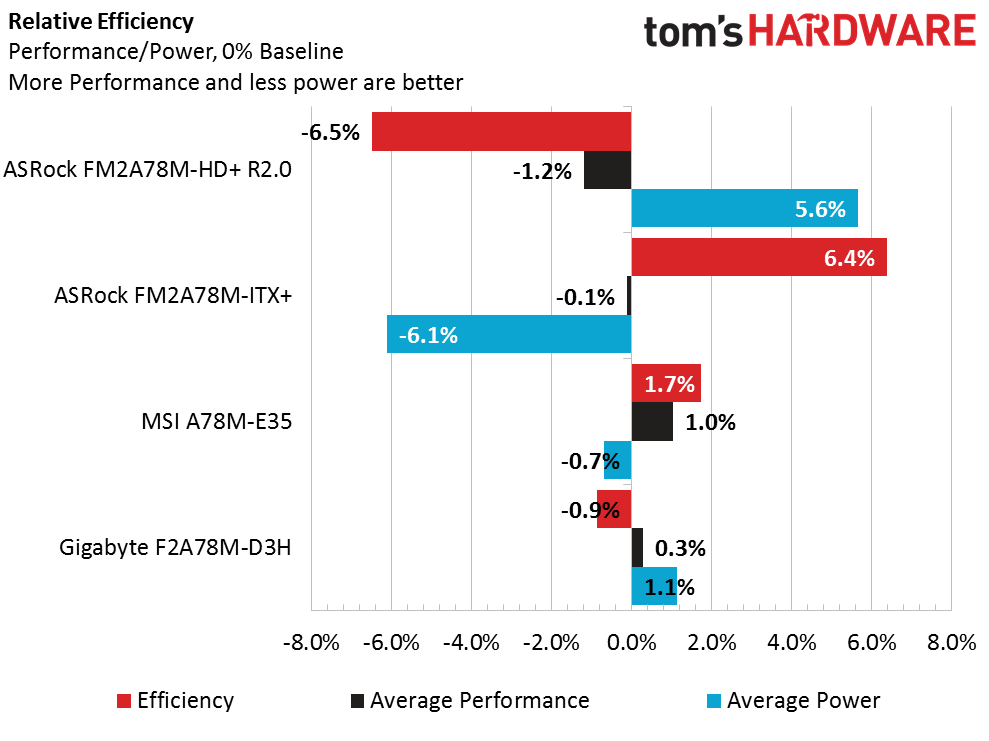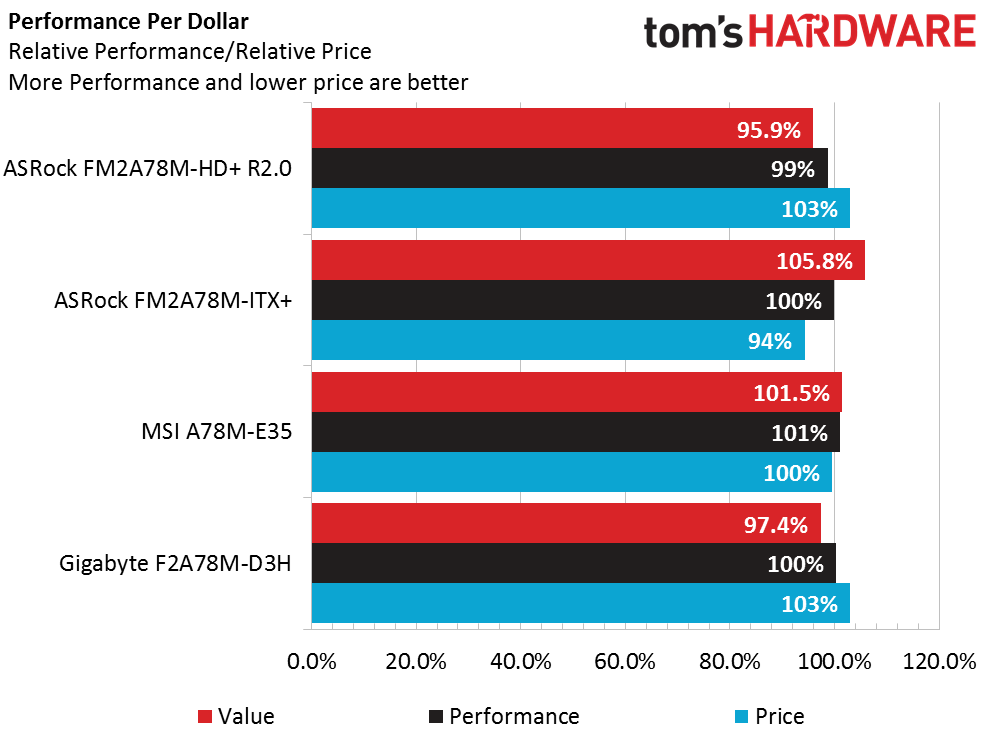ASRock FM2A78M-HD+ & FM2A78M-ITX+ Review
Today, we have a pair of AMD FM2+ boards from ASRock on the test bench: the FM2A78M-HD+ and the FM2A78M-ITX+.
Why you can trust Tom's Hardware
Value & Conclusion
Value


In the end, only 3.5 percentage points separate all the systems, across all of the tests' averages. Judging the trends of the tests, it would appear that the MSI and Gigabyte boards do perform better than both of ASRock's boards, but I would not expect a user to actually detect this difference with an untrained eye.
Efficiency, on the other hand, shows some clear winners. The ASRock ITX+ shows six percent less power consumption compared to the average across all boards, with only a negligible performance hit. The HD+, however, does not have good results in this comparison. It would be interesting to see if these results hold up on another board sample.
At the time of this writing, three of the four boards retail for an average of $60. However, the ITX+ board is retailing for nearly 60 percent more at $84.99! As I shopped around, Newegg shows the ITX+ on sale, and there is an additional rebate that brings this board back into the hunt for a value prize. So, let's use this best-case scenario:
The clear value winner, when on sale, is the ASRock FM2A78M-ITX+. Tie in that value with the ASRock's efficiency and average performance, and this little board is hard to beat. That statement is irrelevant, though, when you look at the retail prices.
The MSI board's retail price gives it a clear advantage when looking just at retail price, but the ASRock HD+ also seems to be a contender due to its average performance and price.
Conclusion
As I said in the previous article, builders looking for value in the APU marketplace who don't need Crossfire or other enthusiast-grade features need look no further than the A78 chipset. We get comparable performance to A88X, and can still adapt this chipset to many usage scenarios and form factors. If you're building an A88X replacement, most of these boards provide formidable overclocking options. For the HTPC crowd, these boards are both efficient and powerful.
The ASRock HD+ is a solid entry-level board that has room to grow. I was disappointed with its efficiency at both idle and load, and its lackluster performance in the test suite. However, if I were looking only at performance, I'd be happy with its performance being less than two percent below average.
Get Tom's Hardware's best news and in-depth reviews, straight to your inbox.
Even though the ASRock ITX+ is the smallest board I've used, it's by far the most surprising. With the different back panel options, audio codecs, and other bells and whistles, the ITX+ will stand out on its own just when you compare the specs. After running this board through the paces, I was happy to see that its efficiency is consistent across workloads and power scenarios. Now I just need to find a small enough enclosure and put this little beast in my living room.
ASRock HD+
ASRock ITX+
MORE: Best MotherboardsMORE:
How To Choose A Motherboard
MORE: All Motherboard Content
Jacob Terkelsen is an Associate Contributing Writer for Tom's Hardware, covering Motherboards.
Follow us on Facebook, Google+, RSS, Twitter and YouTube.
Current page: Value & Conclusion
Prev Page How We Test, Results, Power, Temperature & Overclocking-
FCsean At the time of this writing, three of the four boards retail for an average of $60. However, the ITX+ board is retailing for nearly 60 percent more at $84.99!Reply
Not sure how 84.99 is 60% more than 60. maybe 40%. -
ktolo I still don't know why i keep seeing APU's tested with 1600 memory.. when the world and his dog knows that when you pair these chips with faster memory it unlocks a fair bit more performance. 2133MHz minimum for these APU's - the 7850K can work with 2400MHzReply -
Onus ktolo, you have a point for actual use, however he did mention in the beginning we're all using the same RAM which can allow some direct comparison across all our motherboard review articles.Reply
For my part, as I test a variety of systems, despite sometimes notable benchmark differences, there is little practical difference in the end-user experience. In the bad old days of single and dual-core CPUs, everything mattered at the margin; now I think that is less true. This may be why AMD still manages to sell CPUs, as long as the price is right. Intel may indeed run rings around them, but in actual use the difference doesn't feel that great. -
TheTerk ReplyAt the time of this writing, three of the four boards retail for an average of $60. However, the ITX+ board is retailing for nearly 60 percent more at $84.99!
The ITX+ retails on Newegg for $95 bucks. It is currently on sale for $84 and it looks like the rebate is still available until the end of January.
Not sure how 84.99 is 60% more than 60. maybe 40%. -
Crashman We love the Terk. Unfortunately, motherboard companies aren't loving AMD at the moment: Getting samples has been a problem. So if anyone knows about something released in the past year that we should have tested, speak up and we'll pester those companies.Reply -
damric I have been known to crossfire on the A88X platform. The platform has numerous advantages over AM3+, including PCIE 3.0, CPU on-die northbridge, and lack of Hyper Transport bottleneck. Also Steamroller cores have more IPC and twice as many decoders per module as Piledriver cores. I'm not sure why anyone would purchase an AM3+ platform at this point actually, unless getting one very cheap second hand.Reply -
RedJaron Jake, as you say, A88X boards tend to have somewhat better components than A78 boards. To the APU tweaker and tuner, the higher quality board would be appreciated in OCing. The value of FM2 and APU OCing is of course a whole 'nother topic, but if you're going to do it, I would generally prefer an A88X board.Reply
You are quite right that a media and HTPC can do well on the cheaper A78, just like I'd go with a B85 or H81 on the Intel side for such a machine. -
logainofhades The newegg link, for the M-ITX board, on the last page, takes you to the M-ATX one, for some reason.Reply -
Rexolaboy DDR3 1600mhz with an APU? At least see how adding the 2133mhz ram improves performance. We see overclocked GPU's in reviews, you even oced the CPU in this review, but 1600mhz ram is almost pointless in an APU platform, especially when the price difference is maybe $10-$15 for 2x4 gb. I would have liked seeing a current review of AMD Dual Graphics with the motherboard and new Crimson Drivers. Guess I'll have to watch more foreign youtube videos.... :(Reply
